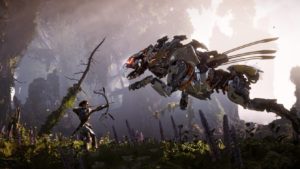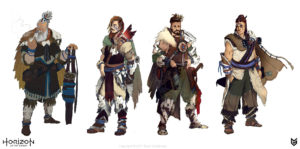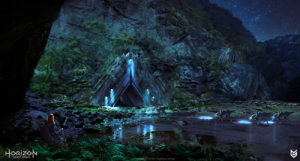
Horizon Zero Dawn is PS4 exclusive, open-world action role-playing video game. It was developed by Guerrilla Games and published by Sony Interactive Entertainment in spring 2017.
The game set in a post-apocalyptic world where intelligent – and deadly – machines co-exist with bronze-age tribes. The protagonist Aloy, armed with both bow-and-arrow and futuristic gadgets at once, sets out to discover the truth about her birth, which is fatefully tied with the history of the world.
The game immediately distinguished itself as one of the best games of 2017 with its stunning visuals, exhilarating combat, and an intriguing plot. This post will analyse the reasons for the game’s success under the lenses of the essential experience, the elemental tetrad, the visible progress, the flow, and the reward.
Lens #2: The Essential Experience
The essential experience of the game is that of an expert hunter taking down her preys and Horizon delivers well on its promises. The player takes an active role in all three parts of a hunt: planning, stalking and confronting.
- Planning: Analyse the machine for strengths and weaknesses in order to select a suitable load-out of weapons and armour. For example: using tripwire to catch invisible machine or rope-caster to tie down flying ones.
- Stalking: Observe machine’s movement pattern and make use of environmental features such as tall grass or river to lay traps and sneak up to the enemy.
- Confronting: Thrilling and fast-pace real-time combat in which the player switches between a maximum of 12 different types of arrows/bombs/traps while trying to doge the machine’s attacks and lure it into traps at the same time.
Every aspect of the game, from its expansive arsenal to its environment design, from its physics to its dialogues, enhances the experience of being a hunter. Everyone calls the player a hunter, gives her hunting jobs and awards her for being good at hunting. The player herself takes great effort to prepare the best possible weapon combination and exercises excellent skills and reflexes during a fight. Everything builds up to a great pay-off when a machine is killed and the player – justifiably – feels like a hunter of high calibre.
Lens #9: The Elemental Tetrad
The game’s the four elements are in harmony with one another and create an authentic and consistent thematic feel throughout.
Story: Horizon tells a story that is both mysterious and familiar. We are introduced to different tribes who practice various superstitions because they cannot comprehend the technology left over from “the ones who came before” like the Nora who worship All-Mother, a factory deep inside the mountain, and the Banuk who follow the Songs – electromagnetic signals that are broadcasted to control machines. The story sets Aloy and the player up for an adventure to different parts of the world in a quest to put together an explanation and learn about the true origin of the world.

Aesthetics: The tone and mood of the story are captured very well in the design of its characters and environments. Characters wear tribal outfit made of furs and leathers but interwoven with metal plates or synthetic accessory that look futuristic even to us in the 21st century. The environment is likewise teemed with thick foliage and majestic mountains, interspersed with metallic bunkers. The colour palette ranges from earth tone hues of green and brown to sci-fi-esque neon blue and purple.
Technology: The game was developed with a proprietor engine named Decima. The engine is capable of 4K-quality textures, intensive natural weather effects like rain storm and blizzard, and multiple particle effects of elemental explosions and lightings. The ability to blend these visual styles seamlessly while maintaining a high frame rate is crucial to the game success.
Mechanics: Aloy can employ various methods to take down an opponent from low-tech ones like stalking in the bush and throwing rocks to distract to high-tech ones like shooting elemental grenades and overriding machines’ CPU. She can watch holo-tape one moment and gather medical herbs the next. The mechanics clearly portrays Aloy as a child of both world in accordance with its story and theme and gives the player a genuine experience of living in a world where technology completely blends with tribal lifestyle.

Lens #55: The Visible Progress
Progress is constantly communicated to the player by the game via:
- Skill tree: skills at the end of the tree are much more powerful than those at the beginning. For example, one allows the player to re-use any weapon upgrade or recover unused traps.
- Weapons/Armours: higher-tier armours and weapons are visually more striking and also come with higher stats, more modification slots, and more ammo types.
- Enemies: machines get bigger and stronger, and come with more mechanics as the game progress. Taking these stronger ones out gives the player clear indication of progress.
- Exploration: as Aloy sees more of the world, she gets her hand on more resources, ability to override more machines, and more data-pad, holo-tapes about the previous civilization.
- Story: As the game goes by, the player learns more about the main plot as well as the history of the world. The player gets closer to the truth, which is the ultimate form of progress.
The player reliably feels a sense of progress in every play session due to this multitude of feedback.
Lens #34: Skill
Horizon demands two types of skills:
- Research: players are encouraged to plan and prepare for each encounter. Their effectiveness is directly proportional to their effort spent in researching.
- Reflexes: at the same time players need to have good reflexes to shoot their arrow accurately at small parts on moving targets, dodge enemies’ attack and aim melee strikes.
These two skills are kept in a good balance and complement each other. A player with poor reflexes can prepare more and vice versa. This allows more types of players play the game and the difficulty levels can be adjusted on the fly. Lastly, the skills are coherent with the essential experience and the story, creating a solid core mechanics that the player will enjoy thoroughly.
Lens #46: Reward

The game gives out both subtle and tangible rewards of many types. Here are some of the notable ones that further enhance the game’s experience and mechanics:
- XP: killing enemies and finishing quests give XP. But killing enemy in a special ways (stealth, headshot, etc.) and complete extra objectives give extra XP. This encourages creative problem solving.
- Gears: gears cannot be bought only with cash but with special loots from enemies. This encourages the hunting aspect of the game.
- Override: completing the game dungeons (named Cauldron) rewards the players with ability to override more machines to ride or fight with. This encourages exploration.
Once again, the rewards work in tandem with other aspects of the game to highlight its hunting mechanics and mixed-lore world building.
